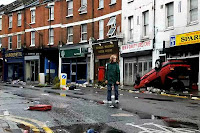
Robert Carlyle is cooking dinner. The room is candlelit. There aren’t enough tomatoes, but there are five tins of chick peas. “That should last at least five year,” he jokes. From this, we can deduce several things. After a great national disaster, life goes on. Families and friendships endure. And even if the end of the world is nigh, Bobby Carlyle won’t eat hummus.
This is the opening scene of the sequel to
28 Days Later, the low-budget, British horror by the team that made The Beach; director Danny Boyle, producer Andrew Macdonald, writer Alex Garland. That film had its roots in the disappointments of The Beach, and was preceded by the two digital dramas Boyle shot for television -
Vacuuming Completely Nude In Paradise and
Strumpet. It’s fair to say that these TV films regenerated Boyle’s creativity: when the director introduced them at the Edinburgh film festival in 2001, he was evangelical about the possibilities of DV; the cameras were small, you could shoot endless footage in bad light, the actors were less precious. All of which he rolled into
28 Days Later, conceived as a treatise on the various forms of rage which were preoccupying newspaper headlines at the time, but which also worked as an ironic commentary on the 57 varieties of dread which followed, notably SARS and bird flu.
28 Days Later was doomed from the moment Christopher Eccleston appeared, but had two things going for it. It’s depiction of a still, deserted London, was eerie and haunting. And the film had a brash immediacy which connected it to a popcorn-eating audience in a manner that is rare in British cinema.
Boyle, Macdonald and Garland are elevated to executive positions for the sequel, and directorial duties are taken on by the Canarian Juan Carlos Fresnadillo, whose debut,
Intacto, explored the downsides of luck. Fresnadillo’s skewed outlook has its roots in a childhood memory. At the age of nine, he was in a traffic jam when two planes crashed on the runway at Tenerife, and he has said that he recalls the face of the policeman peering through the car window as being strange and wild, like that of somebody who had been through hell. It is no plot-spoiler to reveal that that face occurs frequently in
28 Weeks Later. Carlyle gets to try it, as he runs guiltily from “the Infected”, and he causes it too, when his own ravenous urges emerge.
The action, which mostly involves running away and screaming, occurs six months after the initial outbreak. The rage virus has, for now, been contained, and the first children are returning to Britain. Carlyle plays a father, welcoming his two kids – Tammy (Imogen Poots) and Andy (Mackintosh Muggleton) - back to an apartment on the 25th floor of Canary Wharf. The Isle of Dogs is a quarantined Green Zone, patrolled by the US-led NATO troops. The Docklands is a perfect backdrop for horror, with its mix of brash tower blocks and post-industrial dereliction. In the post-9/11 world, it is less surprising than it should be to see tanks at City Airport, armed troops lining the walkways, and a woman in fatigues giving a safety demonstration on the Docklands Light Railway.
Needless to say, the kids soon tire of incarceration, and take a trip back to their old home. Observed all the way by snipers, they steal an abandoned pizza delivery moped for a ride across the empty Tower Bridge, and on, through grim estates and graveyards, as the sun sets behind the Millennium Dome. On arriving, they are as shocked as the audience is not to discover that the house isn’t empty.
Plot is less important than the rising waves of horror which drive the film, so it is best to reveal little more about the story. There are moments of incredulity – not least the bit where Carlyle is tempted into an intimate embrace with one of the Infected – but these are merely brakes on the action, which pulsates between a suggestive fear of the dark and full-on zombie splatter.
Fresnadillo’s use of London is expansive. The horror now extends from St Paul’s to Wembley Way. There is a splash of napalm, too, perhaps in tribute to Boyle’s favourite film,
Apocalypse Now. The metaphorical target has broadened too: the NATO response to civilian disorder is a Code Red, which is quickly upgraded from selective targeting to “shoot everything”.
After containment comes extermination. Don’t you hate it when that happens?


After a great national disaster life goes on, but does it, and how. I'm off to buy five tins of chick peas right now.
ReplyDeleteY:-) Paddy